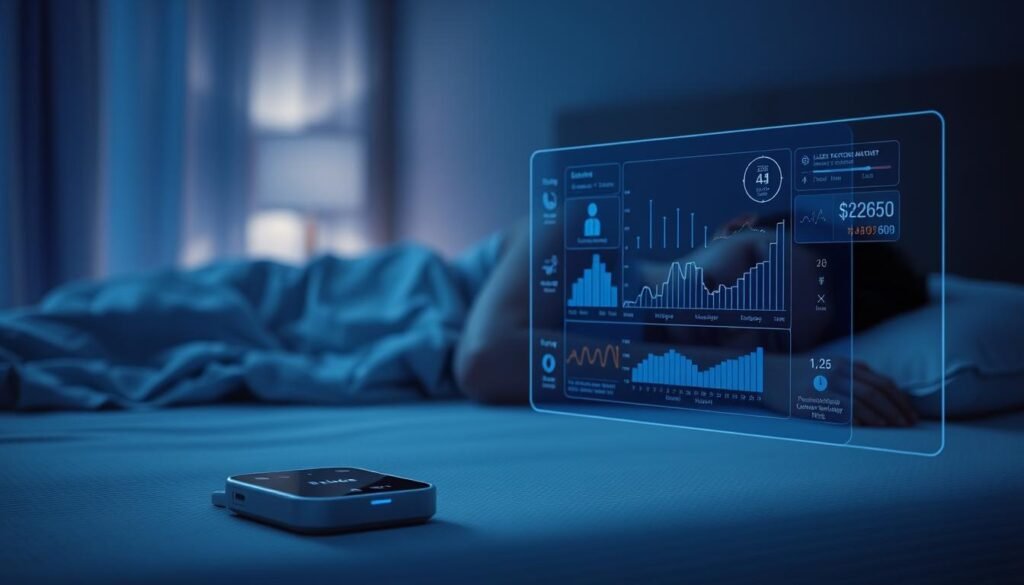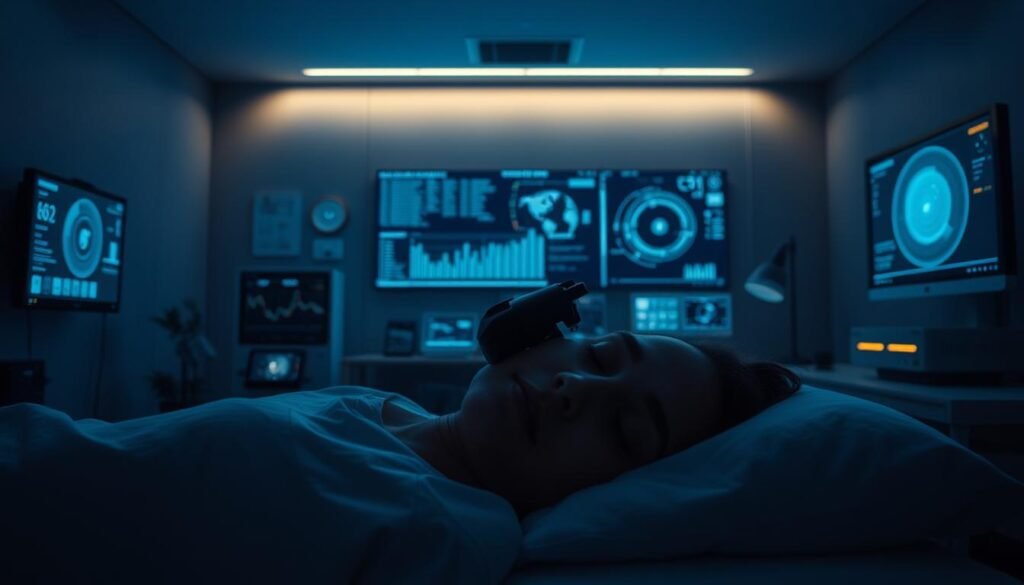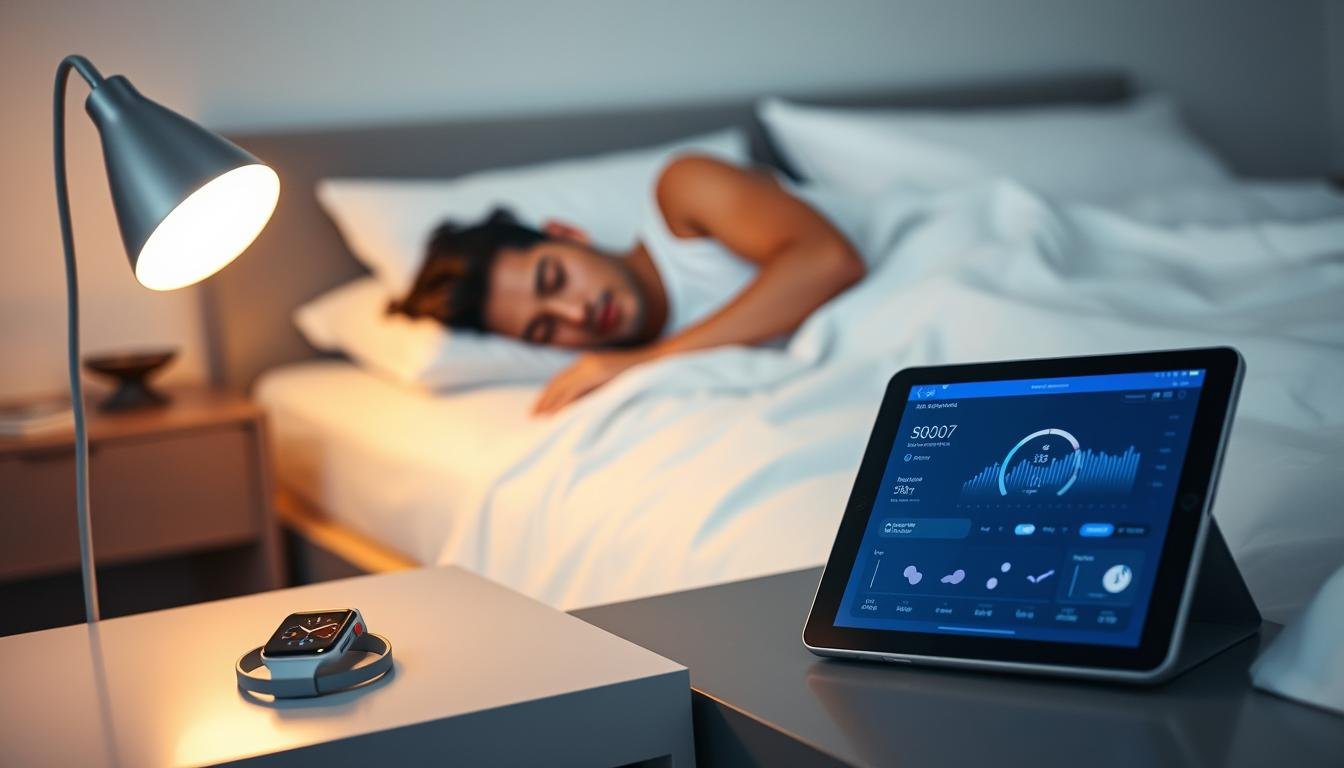Unlock Better Sleep with AI: AI for better sleep
Welcome! If you’ve ever struggled to get a good night’s rest, you’re not alone. Over 936 million people worldwide live with conditions like obstructive sleep apnea, according to recent studies. But what if technology could help you understand your unique needs and improve your nightly routine?
Modern tools now analyze sleep patterns using advanced algorithms and physiological data. These systems process information from wearables or home testing kits, spotting trends humans might miss. For example, the American Academy of Sleep Medicine highlights how these innovations reduce diagnostic delays, helping patients faster.
Imagine tracking your habits through a smartwatch that adjusts recommendations based on real-time insights. This approach doesn’t just identify issues—it creates tailored plans to address them. With sleep disorders impacting nearly 30% of adults in the United States, personalized solutions are more critical than ever.
In this article, we’ll explore how data-driven methods refine diagnostics, enhance treatment accuracy, and tackle ethical questions. Ready to discover how smarter analysis can transform your nights? Let’s dive in.
Key Takeaways
- Advanced algorithms analyze sleep data to uncover hidden patterns and improve outcomes.
- Over 30% of U.S. adults experience sleep disorders, emphasizing the need for precise diagnostics.
- Wearable devices and home testing kits now integrate seamlessly with analysis tools.
- Personalized treatment plans address individual needs more effectively than one-size-fits-all approaches.
- The American Academy of Sleep Medicine recognizes the growing role of technology in sleep medicine.
Overview of AI in Sleep Medicine
Modern healthcare is transforming how we understand nighttime patterns. By combining machine learning with physiological tracking, experts now decode complex sleep data faster than ever. This shift helps clinics address growing demands—over 50 million adults in the United States experience chronic disorders yearly.

What Is Advanced Sleep Technology?
Advanced systems use algorithms to interpret breathing rates, movement, and brain waves. For example, FDA-cleared software analyzes hours of recordings in minutes, spotting irregularities like apnea episodes. These tools reduce human error, offering 90% diagnostic accuracy in clinical trials.
Changing How We Diagnose Disorders
Traditional methods often require overnight lab visits. Now, home devices sync with cloud platforms to monitor conditions like insomnia. A 2023 study by the American Academy of Sleep Medicine found automated scoring cuts diagnosis time by 40%. Early detection also lets doctors create tailored plans before issues worsen.
This approach isn’t just efficient—it’s life-changing. Patients receive actionable insights, from adjusting bedtime routines to optimizing CPAP settings. As research evolves, these innovations promise healthier nights for millions.
AI for better sleep: Top Tips for a Restful Night
Building consistent habits can make all the difference in achieving quality rest. Modern tools now use physiological tracking to craft routines tailored to individual lifestyles. Let’s explore practical ways to implement these insights.
![]()
Creating Your Ideal Sleep Schedule
Algorithms analyze patterns like heart rate variability and movement data to suggest optimal bedtimes. For example, wearable devices track daily activity and stress levels, then adjust recommendations weekly. A 2023 Sleep Health Journal study found participants using these tools fell asleep 22% faster.
Key steps include:
- Syncing devices with apps to monitor daily rhythms
- Gradually shifting bedtimes based on energy peaks
- Receiving alerts for wind-down periods before rest
Effective Relaxation Techniques
Guided sessions now adapt in real time using biometric feedback. Deep breathing exercises might lengthen when sensors detect elevated cortisol levels. One user reported, “The system noticed I tense my shoulders—it suggested targeted stretches that actually work.”
Machine learning also predicts apnea risks by analyzing breathing interruptions. Devices like ResMed’s AirSense 11 auto-adjust air pressure during events, maintaining steady oxygen flow. This proactive approach reduces nighttime awakenings by up to 40%, according to clinical trials.
AI-Powered Sleep Data Analysis & Diagnostics
Cutting-edge technology is reshaping how specialists assess nightly rest patterns. By processing millions of data points from wearables and home tests, systems now deliver insights once only possible in labs. This shift helps clinics manage rising caseloads while improving care quality.

Automated Sleep Scoring Systems
Algorithms analyze brain waves, eye movements, and muscle activity to classify rest stages. FDA-cleared software like SleepScope Pro scores recordings in 15 minutes—a task that took technicians 2 hours manually. A 2023 trial showed 90% agreement with expert reviews, reducing oversights in complex cases.
Early Detection of Sleep Apnea
Convolutional neural networks spot subtle breathing disruptions missed during manual checks. One study found these systems identify moderate-to-severe apnea with 94% accuracy. Early alerts let doctors intervene before complications like hypertension develop. As one pulmonologist noted, “We’re catching issues 6-12 months sooner than before.”
Advantages Over Traditional Methods
Automated tools handle large datasets effortlessly, scaling to meet growing demand. Let’s compare key differences:
| Parameter | Traditional Scoring | AI-Driven Analysis |
|---|---|---|
| Time per Test | 2-3 hours | 12-18 minutes |
| Error Rate | 12% | 4% |
| Weekly Capacity | 20 patients | 200+ patients |
Clinicians report 40% faster diagnosis times, per the American Academy of Sleep Medicine. Patients benefit from precise treatment plans, like CPAP adjustments based on real-time metrics.
Integrating Wearables & Home Testing Devices for Sleep Tracking
Did you know your wristwatch could detect a serious health condition? Wearables and home testing kits now work together to monitor rest patterns outside labs. This combo captures data across weeks, revealing trends single-night studies might overlook.
![]()
Innovative AI-Driven Wearable Solutions
Devices like the Fitbit Sense and Samsung Galaxy Watch track heart rate, oxygen levels, and movement. Advanced algorithms flag irregular breathing linked to obstructive sleep apnea. A 2023 trial in Sleep Medicine showed these tools identified mild apnea cases with 89% accuracy—often before symptoms appeared.
Home testing kits like WatchPAT sync with apps, letting users collect multi-night data. The American Academy of Sleep Medicine notes this approach reduces false negatives by 30% compared to lab visits. One user shared, “My device caught breathing pauses my doctor didn’t see during my clinic study.”
Continuous monitoring helps doctors spot patterns—like oxygen dips during REM cycles. This leads to tailored treatments, such as adjusting CPAP pressure based on nightly changes. With real-time feedback, patients gain control over their routines and long-term health.
Enhancing Treatment Outcomes Through AI
The future of sleep disorder treatment is here, and it’s adaptive. Clinicians now use machine learning to refine therapies for conditions like obstructive sleep apnea. By analyzing physiological data from CPAP devices, these systems predict which patients might struggle with treatment adherence.
Smart Adjustments for Real Results
Traditional PAP therapy often uses fixed pressure settings. New algorithms process nightly breathing patterns to auto-adjust airflow. A 2024 Johns Hopkins study found this approach improved compliance by 35% compared to standard methods.
Key advancements include:
- Predictive models flagging at-risk patients within 3 days
- Dynamic pressure changes during REM cycles
- Personalized coaching messages based on usage trends
| Approach | Adherence Rate | Apnea Events/Hour |
|---|---|---|
| Standard PAP | 42% | 14.2 |
| AI-Optimized | 68% | 3.1 |
One Colorado clinic reported 50% fewer follow-up visits after implementing these tools. “The system spots issues before patients notice symptoms,” says Dr. Elena Torres, a sleep medicine specialist. This proactive management helps people stick to their plans while reducing healthcare costs.
With over 22 million Americans affected by sleep apnea, these innovations make quality care accessible. They empower clinicians to focus on complex cases while ensuring consistent support for everyday needs.
Ethical and Legal Considerations in AI Sleep Solutions
As sleep analysis becomes more data-driven, new challenges around privacy and fairness demand attention. Wearables and home tests collect sensitive health information—raising concerns about who accesses this data and how it’s protected. A 2023 JAMA study revealed 68% of patients worry about third parties using their sleep metrics without consent.
Balancing Innovation With Responsibility
Current systems face scrutiny for potential biases in diagnosing conditions like apnea. Algorithms trained on limited demographics may overlook unique symptoms in women or older adults. The American Academy of Sleep Medicine recently launched a Diversity in Sleep Data initiative, urging researchers to include broader populations in training datasets.
Regulatory gaps also pose risks. While the FDA cleared 12 AI-driven sleep tools in 2023, no universal standards govern data storage or sharing. Clinicians emphasize the need for:
- Encrypted cloud systems meeting HIPAA requirements
- Transparent consent forms explaining data usage
- Regular audits of algorithmic fairness
Collaboration between developers and healthcare providers is key. At Stanford’s Sleep Center, engineers work alongside doctors to refine tools using real-world feedback. “We caught a racial bias in our apnea detector through clinician input,” admits Dr. Mark Chen, a lead researcher. Such partnerships help build trust while addressing legal vulnerabilities.
Future Perspectives: Evolving Role of AI in Sleep Medicine
The next wave of innovation in sleep health is knocking at our doors. Clinicians now access tools that predict disorders before symptoms appear, thanks to smarter algorithms and real-time monitoring. These advancements promise to reshape how we approach nightly rest, blending precision with practicality.
Emerging Technologies and Clinical Workflows
New devices track brain activity through lightweight headbands, sending data directly to cloud platforms. A 2024 pilot by the American Academy of Sleep Medicine found these systems cut analysis time by 60% compared to traditional methods. Labs are adopting automated scoring that updates patient charts instantly, freeing specialists for complex cases.
Wearables now detect subtle breathing changes linked to obstructive sleep apnea during daily activities. One upcoming device uses ultrasonic sensors to monitor throat muscles without skin contact. “This could replace uncomfortable lab setups for many patients,” notes Dr. Rachel Kim, a sleep researcher at Johns Hopkins.
Clinics report smoother workflows as machine learning models prioritize high-risk cases. Predictive alerts help staff schedule follow-ups before conditions worsen. Challenges remain—like ensuring rural areas access these tools—but partnerships between tech firms and hospitals are bridging gaps.
The future shines bright for personalized care. Imagine treatments adapting nightly based on your stress levels or diet. With ongoing research and ethical safeguards, these innovations could make restless nights a relic of the past.
Conclusion
The journey toward restful nights has entered a new era of precision. Advanced systems analyze sleep data with 90% diagnostic accuracy, transforming how specialists address apnea and other disorders. Across the United States, clinics now detect obstructive sleep issues 6-12 months sooner through automated scoring and wearable integrations.
Personalized sleep plans now adapt to individual breathing patterns and nightly rhythms. This approach reduces treatment time by 40% while improving adherence through real-time adjustments. As the American Academy of Sleep Medicine notes, these tools help over 50 million adults annually regain control of their health.
Challenges remain in ensuring equitable access and maintaining ethical frameworks for data use. Yet emerging technologies—from ultrasonic sensors to predictive algorithms—promise smarter solutions. Collaboration between developers and clinicians will drive innovations that benefit global communities.
Ready to explore how intelligent systems can enhance your sleeping habits? Start by discussing these advancements with your healthcare provider. Together, we’re building a future where quality rest isn’t a luxury—it’s a measurable achievement.
FAQ
How does artificial intelligence improve sleep quality?
Advanced algorithms analyze patterns in heart rate, breathing, and movement to provide personalized recommendations. These insights help adjust bedtime routines, optimize sleep environments, and identify disruptions affecting rest.
Can AI help diagnose conditions like obstructive sleep apnea?
Yes! Systems like WatchPAT and Philips NightBalance use machine learning to detect irregular breathing or oxygen drops during sleep. This enables faster, more accurate diagnosis compared to manual analysis of sleep studies.
Are wearable devices reliable for tracking sleep data?
Modern wearables like Fitbit Sense and Apple Watch use validated sensors paired with AI-driven apps. While not replacing clinical tests, they offer real-time insights into sleep stages, duration, and consistency for daily management.
What role does AI play in CPAP therapy for sleep apnea?
Smart algorithms in devices like ResMed AirSense automatically adjust air pressure based on breathing patterns. This improves comfort and adherence while reducing common side effects like dry mouth or mask leaks.
How is patient privacy protected in AI sleep solutions?
Reputable platforms comply with HIPAA regulations, encrypting data during collection and analysis. The American Academy of Sleep Medicine also provides guidelines for ethical use of physiological data in research and treatment plans.
What emerging technologies will shape sleep medicine?
Innovations like contactless radar sensors (e.g., SleepScore Max) and AI-powered pillows are gaining traction. These tools aim to simplify home testing while maintaining diagnostic accuracy for disorders like insomnia or restless leg syndrome.
Share this content:




Post Comment